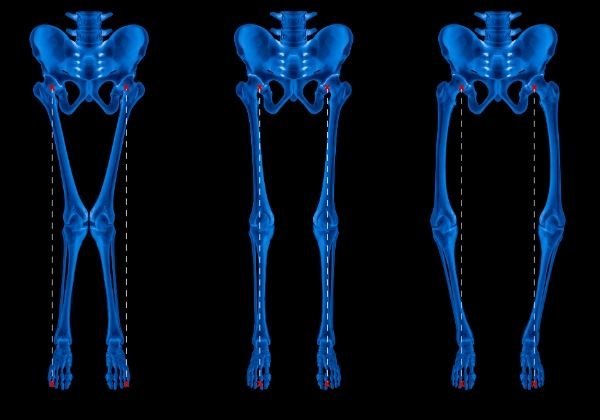Rickets is a bone disease diagnosed in children but can be present in adult carriers that were never treated. This skeletal disorder develops as a result of nutritional deficiencies, causing weak and soft bones.
Without the nutrients needed for proper growth and strength, bones become brittle and can cause stunted growth and deformities. Without treatment, more serious complications can develop, such as frequent breaks and intellectual disability.
What Causes Rickets?
Rickets is caused by a lack of vitamin D, which allows your body to absorb the calcium your bones need. Vitamin D deficiency can develop from a poor diet and a lack of sun exposure.
Without vitamin D, your body produces hormones that cause calcium to be released from the bones. You can also become vitamin D deficient because of digestive disorders that interfere with nutrient absorption, such as celiac disease.
Rickets can also be a secondary development as a result of another condition, such as:
♦ Tumor-induced osteomalacia
♦ Dent’s disease (a rare X-linked recessive inherited condition predominately affecting kidney function)
♦ Epidermal nevus syndrome (a rare genetic disorder causing skeletal and other systemic abnormalities)
♦ McCune Albright syndrome (a genetic disorder that impacts bone growth and development)

Rickets Symptoms
The identifiable symptoms of rickets include:
♦ Stunted growth
♦ Frequent bone fractures
♦ Teeth deformities
♦ Chronic bone pain or tenderness
♦ Large forehead
♦ Skeletal deformities
♦ Curved spine
♦ Large abdomen
♦ Pelvic deformities
There are also certain factors that can impact vitamin D levels and therefore increase the risk for rickets such as:
♦ Having dark skin
♦ Spending little time outdoors
♦ Being breastfed without supplements
♦ Using sunscreen too often
♦ Having a lactose intolerance
♦ Following strict vegetarian diets
Rickets Diagnosis
Your doctor will perform a physical examination to detect rickets. Tenderness in the bones is discovered by lightly pressing down on them, and x-rays can be used to identify bone deformities.
Blood tests may also be done to analyze calcium, vitamin D, and phosphate levels in your bones. Sometimes a biopsy can be done for more in-depth analysis if needed. When levels of both calcium and phosphorus are low, a type of rickets that runs in families is usually the cause.
Treatment for Rickets
The treatment for rickets is designed to correct the unhealthy levels of the nutrients you are missing. Most people experience relief from pain as well as reduced symptoms once nutrient levels are restored.

Restoration of vitamin D and calcium are necessary to slow the progression of rickets, and once levels are normal, bones can heal and regenerate strength. Braces can also be used to help correct bone deformities and support movement as the bones grow. Any genetic form of rickets requires specialized treatment.
Rickets Diet
Maintaining adequate levels of vitamin D and calcium are the key to successfully treating rickets. This can be done through supplements or by adding foods rich in these nutrients to your diet.
Vitamin-D foods:
♦ Salmon and tuna
♦ Fortified breakfast cereals
♦ Yogurt and cheese
♦ Eggs
Calcium foods:
♦ Greens like spinach, kale, and collards
♦ Soybeans
♦ Okra
♦ Almonds
♦ Oranges
♦ Dairy products
When rickets is diagnosed in infants or young children, dietary intake of these nutrients can be done through special formulas that are fortified.
Natural Treatments for Rickets
Dietary changes are the best way to improve bone strength and reduce symptoms of rickets. Because vitamin D can also be produced in your skin with sunlight exposure, getting outdoors more often can also help.
The use of sunscreen is extensive these days thanks to cancer warnings, but sunscreen blocks the vitamin D production that sunlight allows. The best option is to increase your outdoor time, but limit it to the times of day when the sun is not at peak temperatures.

Rickets Surgery
In advanced cases of rickets, surgery can be used to correct bone abnormalities. Osteotomy surgery is done to correct bowed legs.
This procedure is required for bowed legs because the condition cannot correct itself even with growth. The bone structure around the knee is deformed as a result of severe rickets, and normal bone alignment cannot be achieved without surgery.
What Are the Variations of Rickets?
Rickets is a bone disease in children, but when untreated, it can remain through adulthood. The adult version is known as osteomalacia and is characterized by soft bones.
Adults can also develop this version of rickets as a result of celiac disease, which causes intestinal damage and prevents the absorption of nutrients. Liver or kidney disorders can also impact the metabolism of vitamin D, which can contribute to the risk of rickets.
Rickets can also be classified based on the cause. The different types of rickets include:
♦ Vitamin D-deficient rickets
♦ Vitamin D-dependent rickets
♦ Vitamin D-resistant rickets
♦ Hypocalcemia-related rickets
♦ Congenital rickets
Rickets Statistics
♦ Rickets affects 1 in every 200,000 children.
♦ Genetic mutations can also cause rickets, although vitamin D deficiency is the more common cause.
♦ Almost 15 percent of the world’s population is vitamin D deficient.
♦ The incidence of osteomalacia (adult rickets) is about 1 in 1000 people.
Rickets in Children
Rickets is classified as a childhood disorder. While it can appear in adulthood, the diagnosis almost always occurs in children. Even after diagnosis, you can make dietary changes to ensure that children get the nutrients they need.

Treatment is typically successful, and dietary changes cause a reduction in symptoms right away. It is important to continue a balanced and nutrient-filled diet to maintain strong and healthy bones into adulthood.
What Is the Long-Term Outlook?
Rickets can be easily prevented, and cases are rare today. Vitamin D and calcium are essential ingredients in preventing and treating rickets. These need to be introduced at a young age and maintained through life to ensure bones are strong and healthy.
If there are any underlying conditions causing poor nutrient absorption, they need to be addressed first. Identifying and treating the condition early results in the best outcome, and you can live a healthy and active life.






